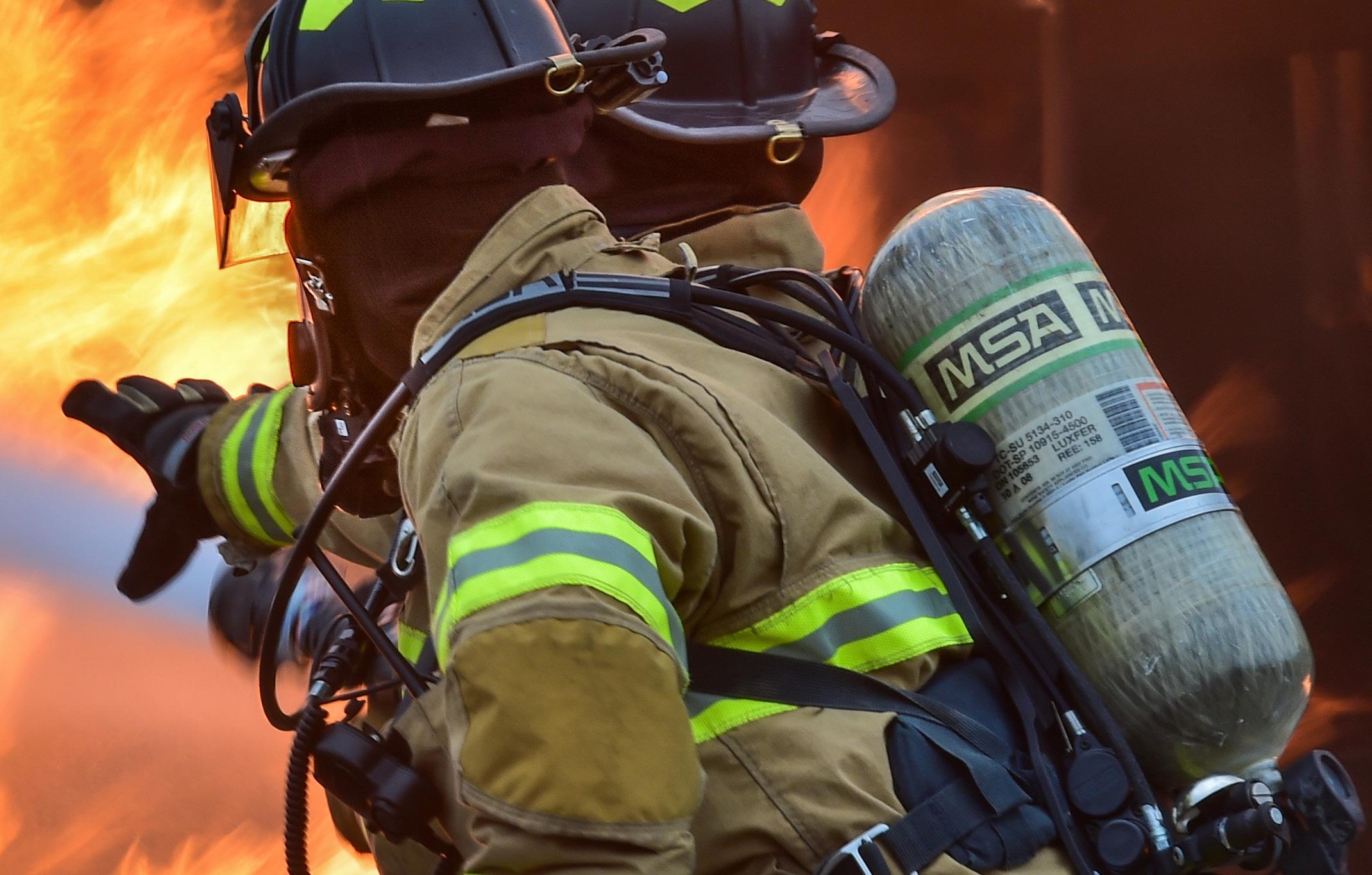
6 minute read
THE LATEST TECHNOLOGY BEHIND THE LIFE-SAVING WORK OF FIRE SERVICES
IN JANUARY 2022, SEVENTEEN PEOPLE LOST
THEIR LIVES IN AN APARTMENT BUILDING FIRE IN THE BRONX, NEW YORK. IT WAS CAUSED BY A SINGLE, DEFECTIVE SPACE HEATER IN ONE, SMALL APARTMENT ROOM, BUT THE LOSS OF LIFE WAS ENORMOUS.
Advertisement
Deadly as these urban fires are, they are only half the story – the other half being taken up by almost constant, horrific images of wildfires all over the world, from Australia to Europe to the American Pacific Northwest.
These fires make headlines so often because their occurrence is increasing. Drier grounds, hotter temperatures, more lightning strikes, unprepared communities – all of these combine to make the threat of damaging fires more severe now than ever. This is the reality that firefighters have to face when reporting to work every day, but one ever-evolving tool in their armoury is the development of new technologies –solutions that make their jobs safer and more efficient.
So, in 2022, what are the tech solutions receiving solid attention?

For starters: data, data, and more data. Data is everything, from in-the-moment information about a blaze and what it might do next, to longer-term information about a fire fighter’s health and well-being. Data will help plan the next moves, judge who is fit to do what, and pinpoint locations across the globe where a wildfire is likely to strike next.
Of course, data means far less to progress if it isn’t shared, and so much of the focus on data depends on different individuals, departments, agencies exchanging it with each other. Only then can they hope to paint the fullest picture of what’s going on. The Internet of Things (IoT) that will fuel this development is expected to feed information on everything from CCTV cameras, to fire detection systems, monitoring technology, gas detection, and even traffic management, so that a fire truck or ambulance racing to the scene of a disaster will have more control of the roads they use.
All of this is so important because it helps firefighters make vital decisions in far less time. Where in a building to tackle first, what kind of gases would someone be exposed to there, where victims might be trapped – all can be delivered today with clarity that hasn’t been seen before. It is also likely to be complemented by increased use of mobile technology, according to international tech giant Samsung. The firm believes that the use of mobile technology in emergency services will “take off” – making use of innovations like 5G data, specialised smartphones to communicate, and view important advanced information such as building plans and wind patterns.
For forest fires, the basic premise is the same. AI and data analytics technologies are being used to give feedback on air quality, environmental conditions, meaning they can more accurately pinpoint locations where a fire is likely to develop next. If it does develop, the data can show what tactics work best to control a blaze and ensure it doesn’t spread.
The pandemic shut down many traditional channels and prompted fire services across the world into a modernisation programme.
Without a doubt, these tech-based developments are still a work in progress. Good data feeding in from so many different sources takes time to roll out properly, but given its vast potential when situations become urgent, it is one to watch this year and beyond.
Going Green
As with so many other industries, tech is also being developed to make firefighting greener. The world continues to pour endless attention into sustainability, particularly after major climate change milestones, like COP26. And now, fire services are jumping on board too. One simple example is the electric fire truck. They are not commonplace yet by any means. In fact, most have barely gotten out of the testing phase.
One was even deployed for active services in the US state of Wisconsin last year. This engine – the first of its kind in America – sits six people, includes a 500-gallon (approx. 1,900L) water tank, and enough space to store over 500m of hose.
“Electric vehicles are the future of fire services,” Steven Davis, Fire Chief in the city of Madison WN where the engine operates, told Industrial Fire World.
“Many communities of Madison’s size have goals to establish green fleets within the next decade. The challenge will be to get city councils to fund the equipment.” Electric fire engines are relatively new and will need to prove that they can match –and eventually replace – the capabilities of traditional engines so that work isn’t compromised. But aside from the example in Madison, more prototypes have been developed in European countries like Austria and Denmark. Watch this space to see when these begin to see active service.
Tracking Health
In the United States, 96 firefighters were killed while on duty, and the majority of those deaths were down to issues that might not commonly grab the most attention.
Over-exertion, stress, and other related medical issues were the proven numberone cause of fatalities amongst these 96 according to Industrial Fire World. Other factors like smoke inhalation, falling objects, and explosions were given heavy attention but didn’t rank as the most important. Out of this problem comes a desire to accurately monitor a firefighter’s health and well-being as far as possible, and new tech solutions are being deployed to do just that.
Smart personal protective equipment (PPE) is being rolled out to those in the field –equipment that can measure heart rate, speed, altitude among other things. If Fire Officers can see this information in real-time, they can question and plan in real-time too They will be able to detect, for example, if and when a firefighter falls to the floor, they ask why, try and make contact, and get a better idea of what that fighter is facing.Similarly, if a firefighter’s heart rate goes into levels that signal overexertion, commanders can instruct them to withdraw until it’s safe to resume their work.
Another big tech solution expected to gain traction this year is mobile mesh networking, designed to address the problem of inadequate communication channels.

This is more of an issue for firefighters working away from urban areas, where connectivity is easy to come by. By contrast, rural areas are commonly affected by lapses in signal, and a lack of terrestrial alternatives should they be needed.

This is where mesh networking comes in. It’s a technology based on interlocking communication “nodes”– much like a WiFi router in a large house and boosters in other rooms.
Mesh networking can enable instantaneous communication in off-the-grid areas, it can do this over a large geographical area if needed, and it’s cheaper to run compared to other communication methods like satellite devices.
The Great Chicago Fire burned ferociously through the city from October 8th to October 10th, 1871, destroyed thousands of buildings and killing an estimated 300 people. The devastation wrought by the conflagration at the time cost an estimated $200 million in damages. The legend goes that the fire was caused by a cow kicking over a lantern in a barn, however other theories surrounding the blaze have laid the blame at arsonists or the possibility that even a meteor might have been responsible for the event that left an area of about four miles long and almost a mile wide of the Windy City, including its business district, in complete ruins. Following the blaze, reconstruction efforts began quickly and spurred great economic development and population growth.
Whatever actually started the fire, there is little dispute of where it started. It had been subsequently proven that on the Sunday evening of October 8, 1871, something ignited a fire inside the barn of Patrick and Catherine O’Leary at 137 De Koven St. on Chicago’s west side.
After the flames had finally subsided on Tuesday morning, the Great Fire had consumed more than three square miles (some 2,000 acres) of the city, taken 300 lives and left 100,000 without homes, which was around a third of the city’s population. Believe it or not, the O’Leary’s house was located upwind of the fire and survived totally undamaged. In the aftermath of the fire 51 people who were near the fire when it broke out, along with experts brought in to examine the scene, came to the conclusion that it was unable to identify the cause. This resulted in a host of other theories being speculated on in the wider community. Apparently there were some inconsistencies in the testimonies of Daniel “Peg Leg” Sullivan and Dennis Regan. Sullivan’s house was located across the road and to the east of the O’Leary’s. He testified that, after visiting the O’Leary’s, he walked across the road, proceeded past his own house, then sat in front of William White’s house, one door up. Sullivan said he could see the fire break out later and ran to the O’Leary’s to help save the animals. This didn’t quite add up for the authorities, due to the fact that the view from William White’s house to the O’Leary barn was









